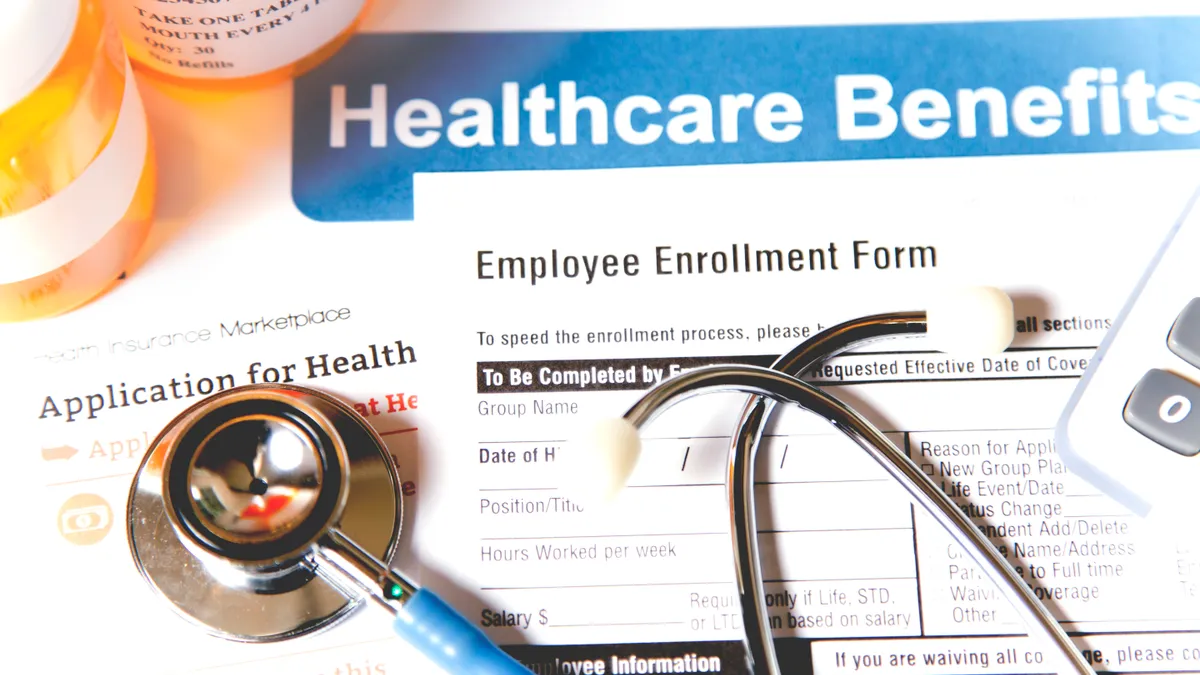Editor’s note: This story is part of the HR Dive Outlook on 2021, a series on the trends that will shape the industry in 2021. For a look at the business trends affecting other industries, see the Dive Outlook on 2021.
Prior to 2020, HR industry observers speculated about the end of a U.S. talent market that had experienced 10 years of increased job gains. In addition to competitive pay, some employers experimented with new and innovative benefits covering areas such as student loan forgiveness, fertility and same-day pay.
The past year's turbulence is likely to disrupt compensation and benefits in several ways. A Gallagher survey published in November, for example, showed that the pandemic disrupted planned 2021 salary increases at 45% of employers surveyed, with 51% saying they expected to reduce salary increases.
The pandemic has not entirely changed pay practices for all organizations, Josh Bersin, global HR analyst and dean of the Josh Bersin Academy, said in an email. Some have increased salaries and benefits along with expanding leave policies, and others are focused on helping employees deal with the financial fallout of 2020. But financial support, Bersin noted, does not drive employee engagement and loyalty by itself.
"Today, workers want to work for a company that they believe in, be part of a team with a leader they admire, and do work they enjoy," he said. "If all these pieces are in place and allied with clear opportunities for learning and growth, compensation actually doesn't need to be particularly above average."
Sources who spoke to HR Dive said benefits professionals will need to pay particular attention to their health plans this year, perhaps a given due to the ongoing global health crisis. From care costs to vaccine coverage to caring for workers' mental and emotional well-being, there's a lot employers and their insurers can prepare to do in spite of the uncertainty ahead.
Benefits teams prepare for vaccination rollouts
Vaccination against COVID-19 looms as potentially the most important storyline for HR in 2021, and benefits professionals will need to pay attention to how vaccination programs take shape at the state and local level, said Mark Hope, senior consultant in Willis Towers Watson's health and benefits practice.
The firm is encouraging clients to cover costs associated with receiving a vaccine, whether employees do so through a doctor's office or pharmacy, Hope added, but "access to vaccines seems to be the biggest question."
Some states have already shifted plans for vaccine distribution with the goal of accelerating vaccinations. New York Gov. Andrew Cuomo announced Jan. 8 that the state would begin moving to its "1B" vaccination phase in which it will allow certain categories of essential workers and individuals over the age 75 to get vaccinated.
On Jan. 12, Health and Human Services Secretary Alex Azar announced that the federal government would release its entire vaccine supply to states rather than hold second doses. Additionally, Azar said the agency would release guidance recommending that state governments open vaccinations those age 65 and over as well as those under age 65 with preexisting conditions.
Still, each state has its own pathway to distributing vaccines, according to Hope, meaning that the processes by which employees get in line to be vaccinated will also differ, often determined by state health departments. "My hope is that there becomes a consistent federal response with better guidelines," he said. "It's not clear if and when it's going to happen."
Members of the Northeast Business Group on Health (NEBGH), a regional coalition of employers and healthcare stakeholders, have asked questions about vaccine rollouts and about whether particular types of workers qualify as essential workers, NEBGH CEO Candice Sherman said. But with guidance changing on a day-to-day basis, there is still a "good deal of uncertainty," she added.
Sources who previously spoke to HR Dive described incentivizing vaccination as one potential avenue for employers worried about the impact of other policies, such as a vaccine mandate. While Sherman said NEBGH has not heard much from members with respect to incentives, "I frankly am in favor of incentivizing." She added that employers may want to work with health plans and pharmacy partners to ensure employees and their families have access to good information about vaccine availability.
Employers, in connection with their health plans, may be able to look into concepts such as drive-thru vaccination clinics once vaccines become more broadly available, Sherman said. Some states are already beginning to experiment with this specific idea. Florida announced plans this week to open a golf cart drive-thru vaccination clinic for seniors at one retirement community, reported ABC affiliate WFTV.
Deferred healthcare costs, treatment are 'top of mind'
The public health crisis posed by the pandemic also had a downstream effect on healthcare across the board, with workers deferring care at an "alarming" rate, particularly during the months of March and April 2020, according to recent study by Castlight Health. The company said patients significantly reduced the use of preventative and elective care during this time.
Insurers also observed the trend of deferred care. Aon, in its Mid-Year Carrier Trend Report from last year, said medical claims for 2020 were projected to increase by 5% less than initially projected for the year, on average. The firm observed a similar impact on dental and vision benefit claims, but did not expect the pandemic to have a material impact on prescription costs.
Deferred care "is very much top of mind for the clients we work with," Hope said, with concerns that employees have put off receiving preventative care or managing chronic health conditions in ways that they otherwise would not. Some, for example, have not gone for blood tests or preventative screenings.
At the same time, employees and their family members may still feel nervous about receiving non-essential care, particularly if they live in areas impacted by COVID-19 surges. That has been the case for some employer members of NEBGH, Sherman said. Employers may need to determine what portion of deferred care within their health plans was low-value care, she added, though employers may not know exactly what the impact of deferred care will be at this point.
Others are noticing a drop in different categories of care. Steven Nelson, president of Contigo Health, an organization that focuses on partnerships between employers and health systems, told HR Dive that elective surgeries and non-COVID vaccinations have been impacted. Elective procedures have been "the bulk of things keeping employers up right now," Nelson said, and health systems have been in various stages of ramping up their operations on this front.
Employers, Nelson said, should begin to prepare for those ramp ups. Hope said employers may want to start examining claims data with their carriers to determine where employees are from a screening and preventative care standpoint. From there, employers can nudge those who have gaps to seek out appropriate care. Provider networks and patient advocacy solutions may also be of help in this regard.
Virtual care is 'here to stay'
Virtual care technologies including telehealth and telemedicine have also played a role in addressing patients' care needs even as physical, on-site care locations faced closures due to public health measures. The pandemic led to "a pretty fast acceleration" of virtual care, Sherman said, even kickstarting creative approaches for specialties that do not typically lend themselves easily to virtual care, such as dentistry and dermatology.
Hope estimates that the pandemic pushed virtual care adoption further than it might otherwise have in 2020; "we took a leap forward by about five years," he said. Virtual care solutions have the benefit of taking away some of the stigma and discomfort associated with in-person visits, such as dealing with travel to and from the provider.
Observers had positively evaluated telehealth during the early months of 2020 for its role in helping to ease pressure on the healthcare system. The relaxation of certain regulatory guardrails also helped the technology flourish in the past year. For example, the Coronavirus Aid, Relief and Economic Security (CARES) Act allowed high-deductible health plans with health savings accounts to cover a patient's telehealth services prior to the patient reaching their deductible.
The trend is also playing out in the carrier space, with a number of insurers piloting digital health primary care provider networks. Examples include Premera Blue Cross, which announced the launch of its network in May, Healthcare Finance News reported. Humana has created a similar partnership with Doctor On Demand, and Kaiser Permanente is also piloting the concept, Hope said.
However, virtual care has mainly expanded within the specialties in which it had already been used, according to Nelson. Plenty of specialties do not lend themselves easily to the format, and certain procedures cannot be performed virtually. And while some services have adapted to accommodate increased demand for virtual care, not all services have done so, Nelson said.
While some analysts who previously spoke to HR Dive said they anticipate that virtual care will continue to see success post-pandemic, Hope and Nelson both identified hurdles to the format moving forward. State and local regulations on virtual care continue to challenge the solutions' growth, Hope said, and insurers are still working through questions such as whether virtual care visits deserve parity with in-person visits for cost purposes.
The most important development for virtual care may be that the past year has laid the groundwork for services to grow, Nelson said. 2020 saw a number of positive developments: more infrastructure placed around virtual visits, more reciprocity for telehealth licenses between states and more carrier activity. Essentially, healthcare stakeholders have been busy "laying the train tracks" for virtual care, Nelson said.
Virtual care is also noted for its role in addressing the mental and emotional well-being challenges associated with the pandemic. Formats such as virtual support groups have become a lot more common for employers, said Carolina Valencia, research director at Gartner for HR Leaders. Well-being apps such as Calm and Headspace have partnered with employers to offer workers free trials, and some employers have built out virtual support groups that include "mental health champions."
Large employers in particular were already largely using virtual care as part of their mental health benefits strategies, or were considering doing so, according to 2020 data from the Business Group on Health. But the past year has sparked a different type of conversation in the realm of mental health support: namely, ensuring that employees have access to counselors who understand their particular backgrounds, Hope said.
Employers can address the diverse mental health needs of employees by working with carriers to allow employees to choose from an equally diverse pool of providers, Hope said, though some carriers are ahead of others in terms of providing a greater demographic mix of providers.
Expect a 2021 'reset' for voluntary benefits
On the voluntary side of things, employers may see "a bit of a reset" in 2021, said Lydia Jilek, senior consultant at Willis Towers Watson. Employers have noticed interest in benefits covering areas such as identity theft due to the increased number of employees working from home, and supplemental medical products have also experienced rising demand.
Additionally, the CARES Act included provisions that allowed employers to contribute tax-free to workers' student loan repayments.
While employer-funded options have trended in the past year, employers are also looking for low-cost options, or options that do not carry any additional cost to employers, but that also preserve choice for employees, Jilek said.
Family and childcare support have also emerged as key areas for investment, Valencia said. Some employers are "going above and beyond," she noted, providing paid time off or giving workers a stipend to hire help. Organizations that cannot afford the same level of benefits might seek to incorporate more flexible scheduling models.
Generally, employee well-being and support for the "whole person" have grown to become "central to the company's entire strategy," said Bersin. But employers also need to go beyond providing a suite of well-being benefits by building work environments that are productive, supportive and inclusive, he added.



















